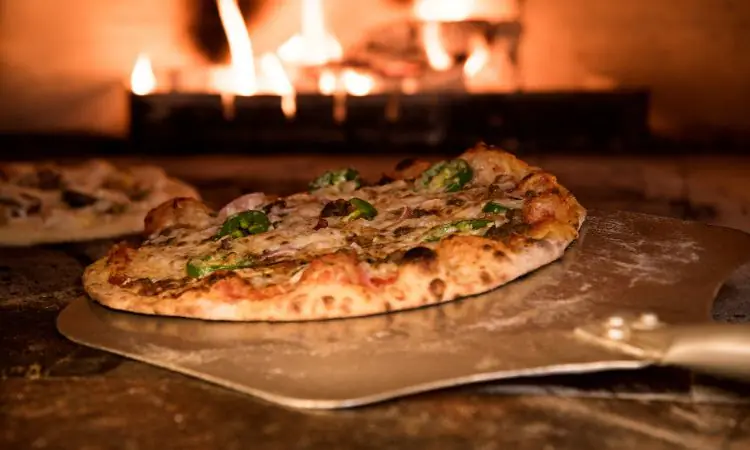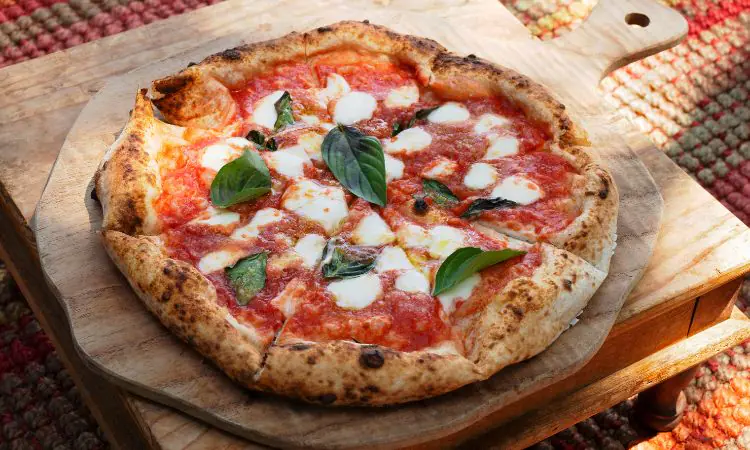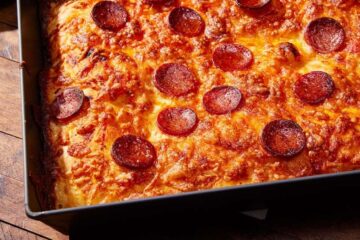How to Get Pizza Not to Stick to Pizza Stone: To prevent pizza from sticking to a pizza stone, ensure the stone is thoroughly preheated and sprinkle it with Cornmeal before baking your pizza. Use a peel to transfer the pizza smoothly to and from the stone.
Ensuring your homemade pizza doesn’t become a sticky mess on your pizza stone is crucial for a satisfying experience. Having the right surface temperature and a dusting of Cornmeal are foundational steps. Preheating your stone in a hot oven for at least 30 minutes is a crucial tactic seasoned home chefs use.
It’s a method that mimics the blistering conditions of professional pizza ovens, creating a crisp base while avoiding the dreaded stick. Armed with these tips, anyone can achieve a pizzeria-quality crust from the comfort of their kitchen, enhancing the at-home dining experience. With a smoothly transitioned pizza onto the stone and a no-fuss release after baking, you’re set for a successful slice situation every time.
The Perils Of Sticky Pizza
No one looks forward to a sticky situation, especially when it involves pizza and a stone. When the dough clings to the stone, it not only wreaks havoc on your meal but also on your mood. Avoid the disaster of a ruined pizza night with some savvy tips to keep that pie sliding off the stone as smoothly as it slid into the oven.
Common Reasons For Pizza Sticking
Understanding why pizza sticks is crucial to preventing it. Here are typical culprits:
- Insufficient preheating: A pizza stone needs to be hot before use.
- Poor dough preparation: Sticky dough often means too much moisture.
- Lack of flour or Cornmeal: They act like tiny ball bearings under the dough.
Impact Of A Sticky Pizza Stone
A sticky situation can lead to more significant issues. Consider the impacts:
- Compromised pizza integrity: A sticking crust can tear and deform.
- Added cleanup time: Scrubbing burned dough off a stone is no one’s fun idea.
- Shortened stone lifespan: Consistent sticking can wear down your pizza stone.

Choosing The Right Pizza Stone
Welcome to the essential guide on preventing your pizza from sticking to your pizza stone! If you need help with your pizza adhering to the stone, the culprit might be your choice of pizza stone. Selecting the suitable pizza stone is fundamental in achieving that perfect crispy crust and easy release. Let’s dive into a good pizza stone’s characteristics so you can bake confidently and savor the results.
Material Matters
The material of a pizza stone plays a significant role in preventing sticking. Consider these popular materials:
- Ceramic: Heats up evenly; great for a crisp crust.
- Cordierite: Handles high temperatures; resists thermal shock.
- Clay: Classic option; requires gradual heating.
Remember, a pizza stone must tolerate high heat and be distributed uniformly. Preheat the stone correctly to avoid sticking.
Size And Shape Considerations
Selecting the right size and shape ensures cooking ease and proper fit in your oven. Consider these points:
| Size | Shape |
| Large enough for your pizza size | Round for traditional pizza |
| Matches oven or grill size | Rectangular for more space |
Ensure your pizza stone has no cracks or chips to avoid failure at high temperatures. An adequately sized stone leads to even cooking and less sticking.
Prepping Your Stone
Dishing out the perfect pizza starts with a well-prepped stone. A ready stone means no sticking, just cooking. Get your pizza stone game strong with these simple steps.
Seasoning Before Use
A fresh pizza stone is just like a new cast iron skillet. It needs seasoning. Seasoning creates a non-stick layer. Here’s how to season it right:
- Clean your stone with warm water. Soap is a no-go. It soaks into the stone.
- Dry the stone with a cloth. Let it air dry thoroughly.
- Apply a thin layer of oil. Use a high smoke points oil like flaxseed or canola.
- Spread the oil with a paper towel. Cover the whole surface.
- Heat your oven to 500 degrees. Place the stone inside for 2 hours.
- Turn off the oven. Let the stone cool in there.
Preheating Techniques
Preheating is your best hack for pizza that slides off the stone. Here’s how to preheat your pizza stone:
- Place the stone in a cold oven. This prevents cracking.
- Set the oven to the highest temperature. 475 to 550 degrees is ideal.
- Wait. Give it about 30 to 60 minutes to soak up the heat.
- Your stone is ready when it’s uniformly hot. Check with an infrared thermometer if you have one.
Dropping dough on a hot stone means instant sizzle. The pizza cooks evenly, and no sticky mess.

Dough Management For Non-stick Results
Nothing spoils a pizza party faster than a pie stuck to the stone. Getting the dough right is the secret to that perfect slide-off-the-stone pizza experience. Let’s break down the steps to ensure the dough is ready for a non-stick performance. Prepare your dough, and you’ll have pizza that cooks evenly and releases smoothly every time.
The Role Of Flour
Flour is the magic dust for pizza stones. Before adding your dough, sprinkle a generous amount of flour on the stone. This creates a barrier, reducing stickiness. Use bread flour or Semolina for the best results. These types of flour create a non-stick layer between the dough and the stone.
- Coat the stone evenly with flour.
- Avoid using too little flour; it might still stick.
- Too much flour can burn and affect the taste.
Proper Dough Hydration
A dough with the proper water content is vital. The well-hydrated dough is pliable and less sticky. But it’s a balancing act. Too wet, and it turns into a gloopy mess. Too dry, and it will cling to the stone for dear life.
| Dough Type | Hydration Level | Notes |
| Neapolitan | High | Sticky but cooks fast |
| New York | Medium | Balanced and stretchy |
| Chicago Deep Dish | Low | Thick and firm |
- Measure water accurately for consistent results.
- Mix gradually to assess the dough’s texture.
- Alter the water amount based on your dough type.
Knead your way to the perfect pizza night with these dough tips, and the next time, your pizza won’t just taste great—it’ll slide right off the stone without a fight.
Application Of Cornmeal And Other Releases
A sprinkle of Cornmeal or other alternatives can make all the difference in ensuring your pizza slides effortlessly off the stone. Let’s explore how applying the right release agents prevents sticking, making your pizza-cooking experience a breeze.
Cornmeal Vs. Semolina
Cornmeal is the classic choice for pizza. It acts like tiny ball bearings beneath the dough. Semolina, a coarser grind of durum wheat, works similarly. Both create a non-stick layer, adding a subtle crunch.
| Cornmeal Benefits | Semolina Advantages |
| Easy to use | Less dusty |
| Crispy texture | Rich flavor |
| Widely available | Nutritional boost |
Choose Cornmeal for a classic pizza base or Semolina for a gourmet touch.
Alternative Non-stick Options
If Cornmeal or Semolina is not your thing, there are other ways. You’ve got options:
- Parchment paper: Slide it under your dough. Remove midway through baking for a crispier bottom.
- Flour: Dusting all-purpose flour can prevent sticking but might not grant a full slip effect like Cornmeal.
- Oil: A thin coat might work, but too much causes smoke at high temperatures.
Remember, preheating your pizza stone is critical. A hot stone makes a crispier crust and reduces stickiness.
Discovering your favorite release method leads to perfect homemade pizza. Experiment to find your best fit.
Optimal Baking Practices
To avoid the heartbreak of a stuck pizza, perfect your baking technique. Proper preparations lead to delicious, non-sticky results. Adopt these baking practices for a flawless pizza experience.
Oven Temperature Insights
A hot stone is the secret to a perfectly baked pizza. Preheat your oven with the stone inside. Aim for 450-500°F (232-260°C), depending on your dough recipe. This heat instantly creates a crisp crust, preventing sticking.
- Preheat your oven for at least 30 minutes with the stone in it.
- Use an oven thermometer to check the stone’s temperature.
- Thick stones may need longer heating times.
Timing Your Bake
Timing is as crucial as temperature. Too long and your pizza will stick or burn; too short and it will be undercooked.
Start checking your pizza around the 5-minute mark. Thin crusts may cook in 5-7 minutes; thicker ones might need up to 10.
| Pizza Type | Cooking Time |
| Thin Crust | 5-7 Minutes |
| Thick Crust | Up to 10 Minutes |
Rotate your pizza halfway through baking to ensure even cooking.
Post-baking Tips
A perfect pizza doesn’t end with the oven’s ding. Caring for your pizza stone afterward is crucial. These post-baking tips guarantee your pizza slides off like a dream every time.
Cooling Your Pizza Stone
Let your stone cool completely. A sudden temperature change can cause cracking. Leave the stone in the oven after you turn it off, or place it on a heat-resistant surface.
Cleaning To Prevent Future Sticking
- Scrape off any leftover bits with a spatula.
- Use a stiff brush and warm water for cleaning; soap can change the stone’s flavor properties.
- Air-dry the stone before storing it.
- Do not submerge your stone in water, as it can lead to cracking.
- For tough stains, bake the stone on high heat for an hour to burn off the residue.
Troubleshooting Common Issues
Experienced pizza chefs and home cooks know a pizza stone is critical for a crispy crust. Yet, sticky dough can turn pizza night into a messy fiasco. If slices are staying stuck, don’t fret just yet. Troubleshooting common issues is easier than you think. These expert tips cut through the hassle, ensuring a clean slice every time.
Dealing With Dough Thickness
The right dough thickness is crucial for a non-stick experience. Too thick, and the dough won’t cook evenly. Too thin, and it might tear or stick. Aim for a balance of about 1/4 inch thickness. Use these steps for perfect thickness every time:
- Start with room temperature dough – This makes rolling or shaping easier.
- Gently flour your rolling surface and rolling pin – But not too much! Excess flour burns, causing stickiness.
- Roll evenly – Press gently from the center outwardly.
- Check thickness by eye – Use this standard before transferring to the pizza stone.
Adjustments For Humid Conditions
Moisture is the enemy when it comes to pizza stones. Humidity can make the dough stickier. Follow these tips to prevent sticking:
- Use less water in your dough recipe – Cut back a tablespoon or two.
- Preheat your pizza stone thoroughly – A hot stone sweats away moisture, reducing stickiness.
- Swiftly transfer toppings – Prepare toppings to minimize their time on the dough.
- Consider a dehumidifier – This tool keeps air and dough drier in highly humid environments.
Upgrading Your Pizza Crafting Tools
Making a perfect pizza starts with the right tools. A quality pizza stone is crucial for a well-baked crust. But even the best pizza stone won’t help if your dough sticks to it. Ensuring your pizza slides off efficiently involves more than just using the stone correctly. The problem may lie with something other than your baking technique but with your pizza crafting tools. Upgrading these may be the solution you need.
Recommended Utensils And Accessories
to handle and serve your pizza are essential. Here’s a list:
- Pizza peel: to transfer your pizza to and from the stone.
- Cornmeal or flour: for dusting the peel to reduce sticking.
- Pizza cutter: for slicing your masterpiece post-baking.
- Baking paper: as an alternative for easy removal.
When To Consider A New Pizza Stone
If your pizza routinely sticks, inspect your stone for damage or wear. Here’s when to get a new one:
- Cracks or significant wear: A smooth surface is critical.
- Uneven heat distribution: This affects cooking and can cause sticking.
- Difficulty cleaning: Old residues can cause sticking.
A new stone can improve your pizza experience significantly.

Frequently Asked Questions Of How To Get Pizza Not To Stick To Pizza Stone
Why Does Pizza Stick To The Pizza Stone?
Pizza often sticks to a pizza stone if the stone needs to be correctly preheated, lacks seasoning, or is due to sticky dough. Ensuring a hot, seasoned stone and well-floured dough reduces sticking.
How To Prevent Pizza Dough From Sticking?
To prevent sticking, preheat the stone for at least 30 minutes. Dust cornmeal or flour on the stone’s surface before placing your pizza. This acts as a protective layer between the stone and the pizza.
What Temp Stops Pizza From Sticking?
It is ideal to heat the pizza stone to 450-500°F (232-260°C) before baking the pizza. This high temperature allows for a quick cook time and prevents the dough from sticking to the stone.
Is Oiling The Pizza Stone Recommended?
Oiling is not recommended; it can damage the stone over time. Instead, dust the surface with Cornmeal or flour for a non-stick surface.
Conclusion
With the proper techniques, a sticky pizza stone is easily avoided. Ensuring a heated stone, proper flouring, and periodic seasoning are key. These simple steps promise a non-stick pizza experience every time. Gather your toppings, prep your dough, and get ready for perfect, hassle-free homemade pizzas from your kitchen!

As the author of the “Ultimate Pizza Guide: Recipes, Tips & Secrets Revealed,” I’m dedicated to sharing my love for pizza and empowering others to create delicious homemade pizzas with ease. Join me on a journey to uncover the secrets to perfecting your pizza game!


